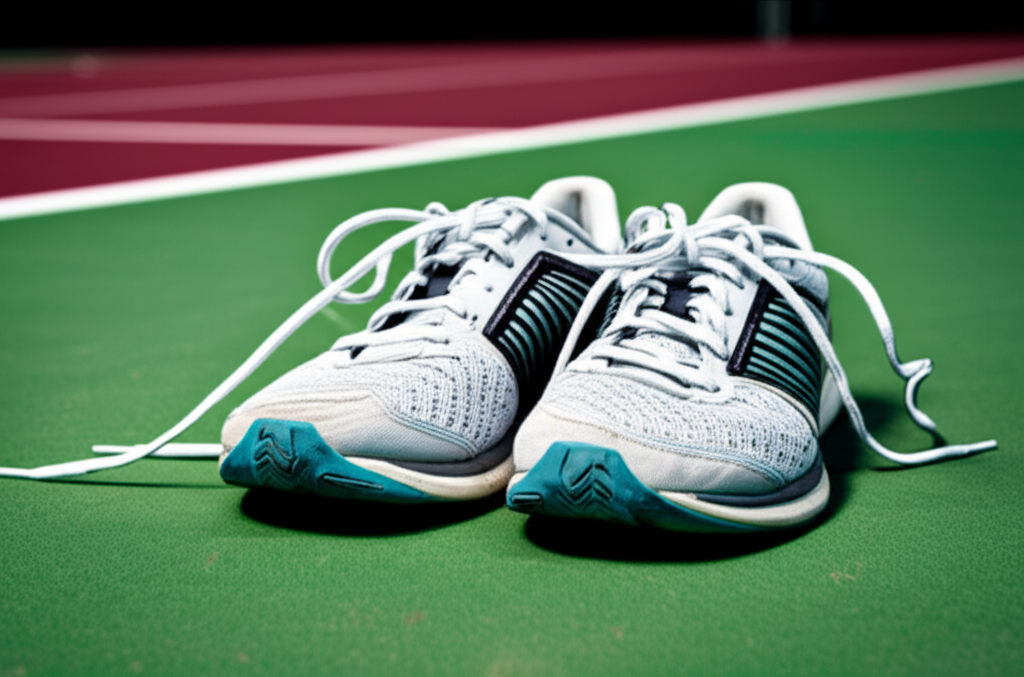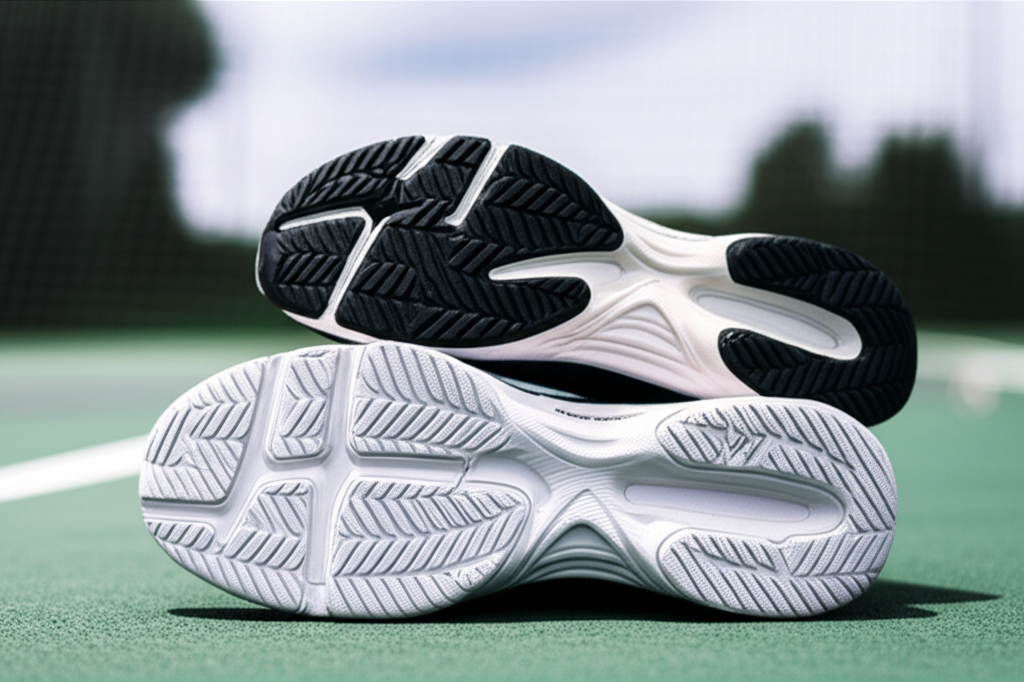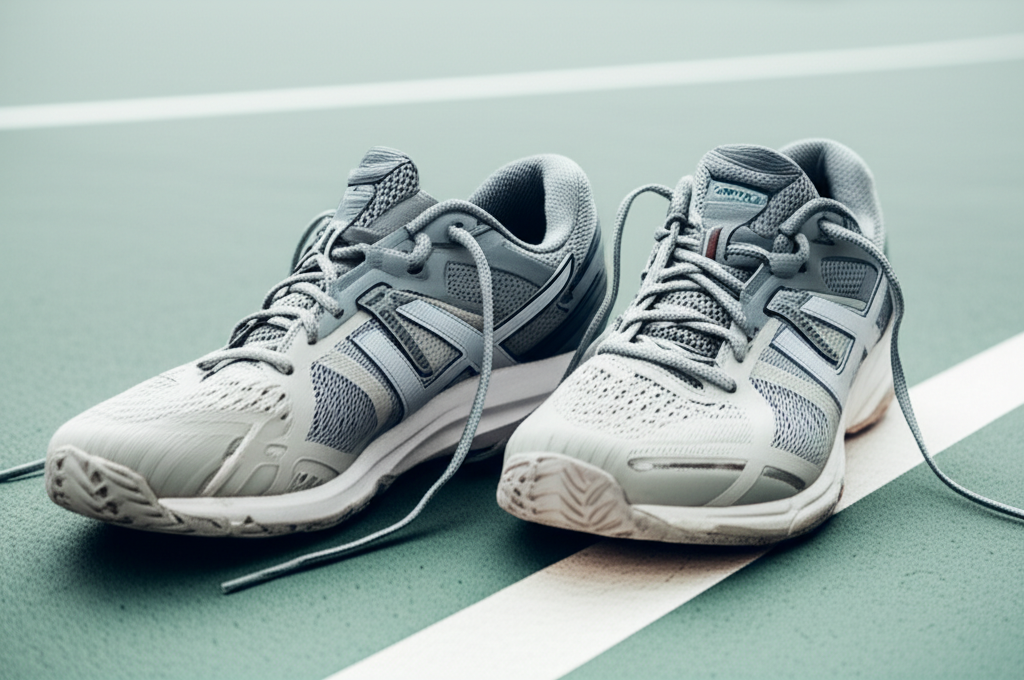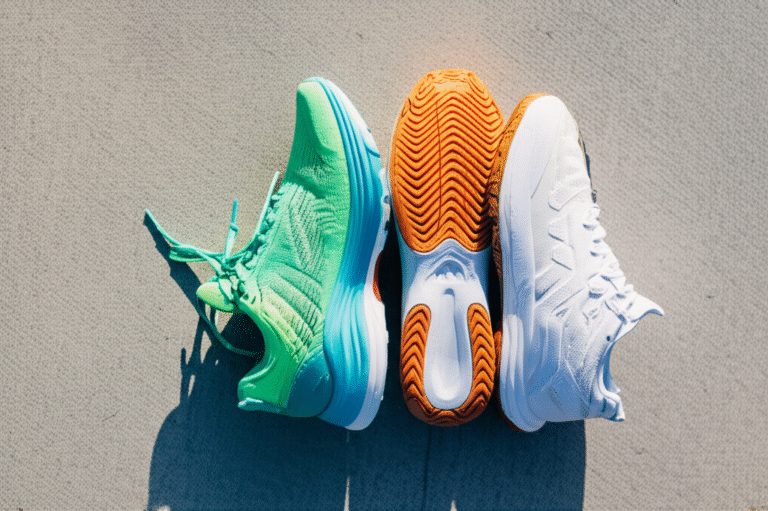Are Running Shoes Good For Tennis? The Shocking Truth Revealed!
No, running shoes are generally not good for tennis. While they offer cushioning for forward motion, they lack the lateral support and durability needed for quick side-to-side movements on the tennis court, increasing injury risk.
Key Takeaways
- Running shoes lack crucial lateral support for tennis.
- Tennis shoes provide enhanced durability on court surfaces.
- Opt for specific tennis shoes to prevent ankle sprains.
- Understand shoe differences to protect your feet.
- Choosing the right shoe boosts performance and comfort.
Stepping onto the tennis court for the first time can be exciting! You’ve got your racket, your water bottle, and you’re ready to play. But what about your shoes? It’s a common question for beginners: can you just wear your favorite running shoes for a game of tennis? This is a really important question because wearing the wrong shoes can lead to discomfort, poor performance, and even injuries. Many people assume all athletic shoes are pretty much the same, but that’s not quite true. Running shoes are designed for one type of movement, while tennis requires a whole different set of foot actions. We’re going to break down exactly why running shoes aren’t ideal for tennis and what you should look for instead. Get ready to understand the differences and make the best choice for your feet and your game.
Why Running Shoes Aren’t Ideal for Tennis
It might seem logical that a shoe built for athletic activity would work for any sport. However, the design and purpose of running shoes are quite different from those made specifically for tennis. Understanding these differences is key to protecting your feet and ankles.
The Mechanics of Running vs. Tennis
Running is primarily a linear activity. Your feet move mostly forward and backward. Running shoes are engineered to provide excellent cushioning and shock absorption for this forward propulsion. They often have softer midsoles and flexible uppers to accommodate the repetitive impact of hitting the pavement or track. The outsole is designed for grip during straight-line motion.
Tennis, on the other hand, is a game of rapid, multi-directional movements. You’re constantly stopping, starting, lunging, and making quick lateral (side-to-side) cuts. This requires a shoe that can support these abrupt changes in direction. Without the right support, your feet and ankles are much more vulnerable to injuries like sprains.
Lack of Lateral Support
This is the biggest issue with using running shoes for tennis. Running shoes typically have flexible side walls and a less structured upper. When you attempt a quick sidestep or a sharp turn on a tennis court, the soft sides of a running shoe can collapse inwards. This instability can easily lead to an ankle roll or sprain. The foot isn’t held securely enough within the shoe to prevent it from rolling over the edge.
Tennis shoes, conversely, feature reinforced side panels and a more rigid upper structure. This provides a stable platform that keeps your foot securely in place, even during aggressive lateral movements. Think of it like the difference between a flexible slipper and a sturdy hiking boot – each is designed for a different purpose and offers a different level of support.
Durability on Court Surfaces
Tennis courts, whether they are clay, hard courts, or grass, can be abrasive. The constant stopping, starting, and dragging of the foot can wear down the outsole of a shoe quickly. Running shoe outsoles are often made of softer rubber compounds optimized for grip on roads or trails. These softer materials will wear out much faster on a tennis court, leading to a loss of traction and potentially damaging the shoe itself.
Tennis shoes use harder, more durable rubber compounds in their outsoles. They are specifically designed to withstand the rigors of court play, providing consistent grip and lasting longer. Many tennis shoes also feature extra reinforcement in high-wear areas, such as the toe box, to further enhance their durability.
Cushioning for Different Impacts
While running shoes excel at cushioning for repetitive forward impact, they might not offer the right kind of cushioning for tennis. Tennis involves a lot of short bursts of movement, quick stops, and jumps, which create different kinds of impact forces. The cushioning in running shoes is optimized for the heel strike and mid-foot push-off of a run. Tennis shoes often have a balance of cushioning that supports both impact absorption and stability for quick movements, without making the shoe too soft and unstable.
Traction and Grip
The outsole pattern on running shoes is designed for forward traction. Tennis shoes, however, have outsoles engineered for multi-directional grip. They often feature herringbone patterns, pivot points, or specific tread designs that allow you to change direction quickly without slipping. A running shoe’s outsole might not provide adequate grip for the sudden stops and starts required in tennis, leading to slips and potential falls.
Understanding Tennis Shoe Features

Now that we know why running shoes fall short, let’s explore what makes a shoe a great tennis shoe. When you look at tennis-specific footwear, you’ll notice distinct features designed to enhance your game and protect your feet.
Lateral Stability
As mentioned, this is paramount. Tennis shoes are built with a wider base and reinforced sidewalls to prevent your foot from rolling over the edge. The upper materials are often stiffer, providing a secure cage-like feel around your foot. This stability allows you to confidently make those aggressive side-to-side movements without worrying about your ankles.
Durable Outsole
Tennis shoe outsoles are made from specialized rubber compounds that are significantly more durable than those on running shoes. They are designed to withstand the abrasive nature of court surfaces. Look for shoes with a robust outsole, often made of carbon rubber in high-wear areas, especially if you play on hard courts frequently. The tread pattern is also crucial, offering optimal grip for quick pivots and stops.
Supportive Midsole
The midsole of a tennis shoe provides cushioning and shock absorption, but it’s also designed for stability. Unlike the soft, sometimes overly yielding midsoles of running shoes, tennis shoe midsoles offer a firmer feel. This firmness helps maintain court feel and provides a stable platform for quick movements, reducing the risk of the foot sinking too deeply and becoming unstable.
Toe Protection
Many tennis players drag their toes during serves, groundstrokes, or when stopping. Tennis shoes often have reinforced toe caps or rubber overlays in the toe area to protect the shoe from excessive wear and tear. This feature extends the life of the shoe and prevents the toe box from breaking down prematurely.
Ankle Support (Optional but Beneficial)
While not all tennis shoes offer high-top designs, some do. High-top tennis shoes provide additional ankle support, which can be beneficial for players prone to ankle sprains or those who feel they need extra stability. However, many low-top tennis shoes offer sufficient ankle support through their overall construction and lacing system.
The Differences in a Nutshell: Running Shoes vs. Tennis Shoes
To make it even clearer, let’s look at a direct comparison of the key features:
| Feature | Running Shoes | Tennis Shoes |
|---|---|---|
| Primary Movement | Linear (forward/backward) | Multi-directional (forward, backward, lateral) |
| Lateral Support | Minimal, flexible sides | High, reinforced sidewalls and rigid upper |
| Outsole Durability | Lower, softer rubber for road/trail grip | Higher, harder rubber for court abrasion |
| Outsole Tread | Designed for forward traction | Designed for multi-directional grip and pivots |
| Midsole Cushioning | Optimized for repetitive impact, often softer | Balanced for impact and stability, firmer |
| Toe Durability | Standard construction | Often reinforced for toe dragging |
| Weight | Can be lighter, depending on model | Generally designed for stability, can be slightly heavier |
| Flexibility | High flexibility for forward motion | Less flexible laterally, more rigid for support |
Common Injuries from Wearing the Wrong Shoes
Ignoring the specific needs of tennis can lead to several common and painful injuries. The most prevalent is:
Ankle Sprains
This is the most common injury associated with wearing running shoes on the tennis court. The lack of lateral support means that when you make a quick side-to-side movement, your ankle can roll outwards, stretching or tearing the ligaments. A severe sprain can sideline you for weeks or even months.
Blisters and Foot Pain
While not as severe as sprains, blisters and general foot pain are common. The friction caused by your foot shifting inside a shoe not designed for its specific movements can lead to painful blisters. The lack of appropriate cushioning and support can also result in arch pain, heel pain, and general fatigue in your feet.
Knee and Hip Issues
The shock absorption in running shoes is tailored for the linear impact of running. When you use them for tennis, the way your body absorbs the impact of quick stops and starts can be altered. This can put undue stress on your knees and hips, potentially leading to pain or more serious issues over time.
For more information on preventing sports injuries, the Stop Sports Injuries website offers excellent resources and advice from leading medical professionals.
What About Other Athletic Shoes?

You might wonder if shoes designed for other sports, like basketball or cross-training, would be better than running shoes. Here’s a quick look:
- Basketball Shoes: These offer good ankle support and lateral stability, making them a better option than running shoes for tennis. However, their outsoles are often designed for indoor courts and might not offer the best grip or durability on outdoor tennis courts.
- Cross-Training Shoes: These are designed for a variety of gym activities and offer a balance of support and flexibility. They are generally more stable than running shoes but may not provide the specific lateral support and outsole grip needed for aggressive tennis play.
- Court Shoes (Squash/Badminton): These are closer to tennis shoes but are typically lighter and more flexible. They might be suitable for very casual play on indoor courts, but dedicated tennis shoes are usually more durable and supportive for the demands of tennis.
Ultimately, for optimal performance and injury prevention, a shoe specifically designed for tennis is the best choice.
Choosing the Right Tennis Shoes for Beginners
Don’t be intimidated by the options! Choosing your first pair of tennis shoes can be straightforward. Here’s a simple guide:
1. Identify Your Playing Surface
Where will you be playing most often? This is the first crucial step.
- Hard Courts: These are the most common. You’ll need a durable shoe with good cushioning and support. Look for shoes designed for hard courts, often labeled as “all-court” or “hard court” shoes.
- Clay Courts: These courts require shoes with a different outsole pattern – usually a herringbone or clay-specific tread. This pattern helps prevent the clay from clumping on the sole and provides excellent grip on loose surfaces.
- Grass Courts: These are less common and require specialized shoes with a very specific sole pattern (often with small nubs or “pimples”) to prevent slipping and minimize damage to the court.
2. Focus on Fit and Comfort
This is non-negotiable. Even the most technically advanced shoe is useless if it doesn’t fit well.
- Try Them On: Always try shoes on before buying. Wear the type of socks you’ll use for tennis.
- Room to Wiggle: Ensure there’s about a thumb’s width of space between your longest toe and the end of the shoe when standing.
- No Pinching or Rubbing: Walk around the store. Pay attention to any pressure points, pinching, or rubbing. The shoe should feel snug but not tight.
- Heel Lock: Your heel should feel secure and not slip up and down as you walk.
3. Consider Support and Stability Features
For beginners, prioritizing stability is wise.
- Look for Reinforced Sides: Gently press the sides of the shoe. They should feel firm and resistant to collapsing.
- Midsole Firmness: The sole shouldn’t feel overly soft or squishy. You want a balance of cushioning and responsiveness.
- Lacing System: A good lacing system allows you to customize the fit and secure your foot properly.
4. Don’t Overspend Initially
You don’t need the most expensive pair to start. Many brands offer excellent entry-level tennis shoes that provide the necessary features for beginners. As you play more and understand your preferences, you can invest in higher-end models.
Pro Tips for Your First Tennis Shoes
When you’re heading out to buy your first pair of tennis shoes, remember these quick tips: If you have any existing foot conditions like plantar fasciitis or flat feet, consult with a podiatrist or a sports medicine specialist. They can recommend specific shoe features or even custom orthotics that can help you play comfortably and safely.
Frequently Asked Questions (FAQ)

Q1: Can I wear my running shoes for a casual hit-around on the tennis court?
While it might be okay for a very light, casual hit-around where you’re not making many quick movements, it’s still not recommended. Even during casual play, you might be tempted to make a quick move, and your running shoes won’t offer the necessary support, putting you at risk of an ankle sprain.
Q2: How often should I replace my tennis shoes?
This depends on how often you play and the court surface. Generally, tennis shoes need replacement every 6-12 months for regular players. Look for signs of wear like worn-out tread, compressed cushioning, or visible damage to the upper. If you notice a loss of traction or support, it’s time for new shoes.
Q3: What is the difference between men’s and women’s tennis shoes?
Men’s and women’s tennis shoes are designed with different foot shapes in mind. Men’s shoes are typically wider, especially in the forefoot, while women’s shoes are narrower. They also differ in cushioning levels and arch support to accommodate typical gender-based foot structures. It’s always best to choose shoes designed for your gender or a unisex model if available and fits well.
Q4: Do I need different shoes for different types of tennis courts?
Yes, ideally. While a good all-court tennis shoe can work on most surfaces, specific shoes offer better performance. Clay court shoes provide superior grip on loose clay, and their patterns prevent clay from sticking. Hard court shoes offer more durability and cushioning for abrasive surfaces. Grass court shoes have unique treads for stability on slippery surfaces.
Q5: Are expensive tennis shoes always better?
Not necessarily. While premium models often feature advanced technologies and lighter materials, the most important factor is the shoe’s fit, comfort, and suitability for your playing style and court surface. Many mid-range and even some entry-level tennis shoes offer excellent support and durability for beginner and intermediate players.
Q6: What if I have wide feet? Can I still find good tennis shoes?
Yes! Many brands offer tennis shoes in wide (2E) or extra-wide (4E) options. It’s important to look for these specifically, as a standard-width shoe will be uncomfortable and could lead to foot issues. Trying on shoes in person or checking product descriptions for width availability is key.
Conclusion
So, to answer the big question directly: are running shoes good for tennis? The honest, and perhaps shocking, truth is that they are not. While they provide cushioning for forward motion, they critically lack the lateral support and durability needed for the dynamic, multi-directional movements of tennis. Wearing running shoes on the court significantly increases your risk of ankle sprains, blisters, and other painful injuries, while also hindering your performance.
Investing in a pair of dedicated tennis shoes is one of the smartest decisions you can make as a tennis player, especially as a beginner. They are specifically engineered with reinforced sidewalls for stability, durable outsoles for traction on court surfaces, and balanced cushioning for responsive play. By understanding the differences and choosing a tennis shoe that fits well and suits your playing style and court surface, you’ll not only protect yourself from injury but also enhance your comfort and confidence on the court. Step onto the court with the right gear, and you’ll be well on your way to enjoying the game to its fullest!

